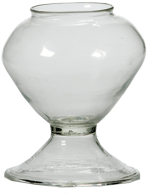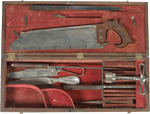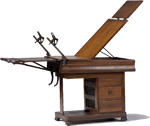|
Cowan's Corner
Antique Medical Instruments Are Out-ofthe-Ordinary Collectibles
By Wes Cowan
Of all the eccentric and unusual
collecting fields, none are perhaps
as haunting and grim as that of early
medical antiques. But if eBay has taught
us anything, it’s that there is a market
for every collector’s whim, and medical
collectibles are no exception.
Medical utensils, devices and tools
produced in the early 19th Century
and earlier serve as a wonderful
documentation of the development of
the profession. In many cases, such
tools can be exceedingly rare because
few were produced, and eventually, a
more sophisticated tool or method was
developed, thus ending its production.
As with other collecting areas, the
same concept applies with medical collectibles—the rarer the object,
the better.
Dental tools provide an excellent
example of this progression. Dental
keys were produced as early as the 17th
century, with steady development of new
models and the continual abandonment
of the older and less sophisticated. An early and rare dental key can command
several thousand dollars at auction.
A fine 19th-Century key with an ivory
handle can bring several hundred dollars.
A dental utensil from the 1950s would
probably be deemed virtually worthless
by a medical antique collector, but many
years from now, it may be viewed as a
veritable jewel, encapsulating a period
of time when dentists worked with such
“crude” tools.
An entire host of other medical
objects were produced that can both
fascinate and horrify. Bloodletting
devices are especially cruel, providing
a glimpse into the long-abandoned
process of extracting blood to cure
certain illnesses. Similarly, leech jars
are especially popular with collectors, as
leeches were used for the same purpose.
Some of the more gruesome utensils
are early surgical and amputation kits.
Used commonly during the Civil War,
a complete amputation kit from an
identified medical officer can command
several thousand dollars at auction.
The industrial age and pioneering
electrical inventions also brought along
an array of interesting medical devices. For example, shocking machines were
developed for persons with “nervous
diseases,” designed to shock an
individual into a normal state.
Outside of actual medical utensils,
collecting items associated with the
medical profession is also popular.
For example, a 19th -Century portrait
of a doctor is more likely to command
a stronger price than an unidentified
portrait of a man. The same is true for
shaving mugs, fraternal items and a
variety of other antiques. On items
such as these, a visual symbol typically
used to signify a doctor was the skull
and crossbones.
Medical collectibles follow the
general rules of antique collecting:
they must be complete with no missing
parts and be in good condition overall.
A documented provenance, tying the
piece to a particular physician or event,
contributes to an item’s value. Of course,
the rarer, and often, the more gruesome
the item is, the higher its worth to
collectors.
To say the least, medical collectibles
cover a vast territory, but are an
interesting field with much to learn
about and discover. Many unusual items
can be great conversation pieces, and
many more are quite “shocking.” At the
very least, these antique medical devices
make us grateful we live in our current
age of technology.
 About the author: Wes Cowan is founder and owner of
Cowan’s Auctions, Inc. in Cincinnati,
Ohio. An internationally recognized
expert in historic Americana, Wes stars
in the PBS television series History
Detectives and is a featured appraiser on
Antiques Roadshow. He can be reached
via email at info@cowans.com. About the author: Wes Cowan is founder and owner of
Cowan’s Auctions, Inc. in Cincinnati,
Ohio. An internationally recognized
expert in historic Americana, Wes stars
in the PBS television series History
Detectives and is a featured appraiser on
Antiques Roadshow. He can be reached
via email at info@cowans.com.
|

Wrought iron dental key with
unique locking mechanism,
estimated to sell for $250/$350.

A fine 19th-Century blown glass leech
jar, estimated at $1,000/$1,500.


|